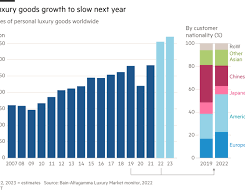Luxury brands brace for a 2023 slowdown, reports the Financial Times: “even the remarkably resilient luxury sector is not immune to economic turbulence, and amid the war in Ukraine, rises in energy prices and interest rates, and the threat of recession in the US and Europe, the fizz appears to be coming off the champagne”. But reopening in China could offset recessions in the US and Europe, is the analysis of FT.
Heading into 2022, the €353bn luxury goods market had reason to celebrate. Covid-19 restrictions had largely eased outside of China, luxury stocks were outperforming the broader equity market for the sixth consecutive year, and shoppers flush with lockdown savings were eager to travel — and dress for it. And they did: after fully recovering from pre-pandemic levels by the end of 2021, sales of luxury goods grew another 15 per cent on a constant currency basis in 2022, according to analysts at Citi and Bain.
But even the remarkably resilient luxury sector is not immune to economic turbulence, and amid the war in Ukraine, rises in energy prices and interest rates, and the threat of recession in the US and Europe, the fizz appears to be coming off the champagne.
A sales slowdown
While the fashion industry is bracing for a small sales contraction next year, according to McKinsey, analysts expect the luxury goods sector will keep growing — albeit more slowly than last year.
How much it grows hinges on the success of China’s reopening and the resilience of the US market. Beijing’s decision this week to ease inbound and outbound travel could lead to a sales lift of 6 to 8 per cent next year, according to Bain partner Claudia D’Arpizio, versus an earlier, more conservative forecast of 3 to 5 per cent. Japan in particular is likely to benefit as Chinese shoppers take advantage of the depressed yen, although the country has said all travellers from China must produce a negative Covid test on arrival, or quarantine for seven days, as case numbers in China soar.
Focus on the ultra-wealthy
Although “aspirational” luxury buyers are already cutting back in the US, spending among the wealthiest 2 per cent of global consumers — who together account for 40 per cent of luxury spending — is still strong, brands and retailers say. Competition for those shoppers will heat up next year, with brands investing further in shows, trips and exclusive experiences. Earlier this year Balenciaga opened a store in Paris for its top spenders, while Chanel is planning to do the same in Asia in 2023.
Brace for price hikes
Although the prices of “core” handbags from brands such as Chanel and Louis Vuitton have already increased 20 per cent or more in the past two years, brands are expected to boost prices on those items even further next year — particularly in Europe, where the depressed euro has made luxury goods comparatively cheap. Prices there could rise 15 per cent next year, and in the mid-single digits in the US and China, says Citi luxury analyst Thomas Chauvet.
As the price gap between leather goods and watches and jewellery shrinks, consumers may see the value in shifting more of their spending to the latter categories, he adds.
A return to formality
A return to socialising, travel and the office has ushered in a return to dressing up — although categories such as sneakers remain important, especially for younger shoppers who see such items as collectibles. There will also be an increased focus on young teens (aka Gen Alpha), who are making their first luxury purchases as early as age 13 — in contrast to Gen Z, who made their first luxury purchases in their late teens. To reach those young would-be shoppers, brands will continue to invest in marketing opportunities in gaming and the metaverse, despite the crash in crypto.
Logos and other flashy signifiers of wealth vanished during the last economic recession in 2009. The same could happen in the US and Europe in 2023, as the post-Covid euphoria wears off and young consumers push back on celebrities who are flaunting their wealth on social media (see: Kylie Jenner’s Christmas tree).
Succession takes shape
Next year will also see fresh faces come to the fore, as new creative directors are slated to be announced at Gucci, Louis Vuitton men’s and Tom Ford, while family-owned companies hand greater responsibility to the next generation. In December, Antoine Arnault, son of LVMH chair and CEO Bernard Arnault, added CEO of Christian Dior SE to his duties. Meanwhile, Prada appointed Andrea Guerra as group CEO to aid the transition of Lorenzo Bertelli, son of Miuccia Prada and Patrizio Bertelli, to eventual CEO. Burberry’s new direction will begin to materialise with Daniel Lee’s first collection for the British brand in February.
Long-term prospects remain bright
While 2023 will be a slower year for the luxury sector, its long-term prospects are strong. According to Bain, sales are forecast to increase by 60 per cent between 2022 and 2030, fuelled by growing numbers of luxury consumers in markets including India, Mexico, South Korea and south-east Asia.



